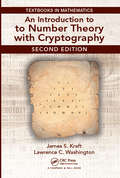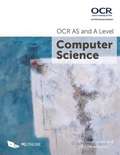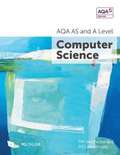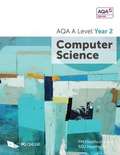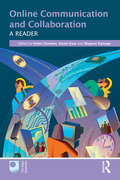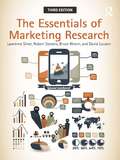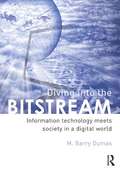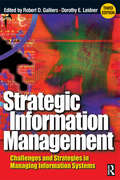- Table View
- List View
Digital Compositing for Film and Video: Production Workflows and Techniques
by Steve WrightWritten by senior compositor, technical director and master trainer Steve Wright, this book condenses years of production experience into an easy-to-read and highly-informative guide suitable for both working and aspiring visual effects artists. This expanded and updated edition of Digital Compositing for Film and Video addresses the problems and difficult choices that professional compositors face on a daily basis with an elegant blend of theory, practical production techniques and workflows. It is written to be software-agnostic, so it is applicable to any brand of software. This edition features many step-by-step workflows, powerful new keying techniques and updates on the latest tech in the visual effects industry. Workflow examples for: Grain Management Lens Distortion Management Merging CGI Render Passes Blending Multiple Keys Photorealistic Color Correction Rotoscoping Production Techniques for: Keying Difficult Greenscreens Replicating Optical Lens Effects Advanced Spill Suppression Fixing Discoloured Edges Adding Interactive Lighting Managing Motion Blur With brand new information on: Working in linear ACES Color Management Light Field Cinematography Planar Tracking Creating Color Difference Keys Premultiply vs. Unpremultiply Deep Compositing VR Stitching 3D Compositing from 2D Images How Color Correction ops Effect Images Color Spaces Retiming Clips Working with Digital Cinema Images OpenColorIO A companion website offers images from the examples discussed in the book allowing readers to experiment with the material first-hand.
An Introduction to Number Theory with Cryptography (Textbooks in Mathematics)
by James Kraft Lawrence WashingtonBuilding on the success of the first edition, An Introduction to Number Theory with Cryptography, Second Edition, increases coverage of the popular and important topic of cryptography, integrating it with traditional topics in number theory. The authors have written the text in an engaging style to reflect number theory's increasing popularity. The book is designed to be used by sophomore, junior, and senior undergraduates, but it is also accessible to advanced high school students and is appropriate for independent study. It includes a few more advanced topics for students who wish to explore beyond the traditional curriculum.
Information Technology Control and Audit, Fifth Edition
by Angel R. OteroThe new fifth edition of Information Technology Control and Audit has been significantly revised to include a comprehensive overview of the IT environment, including revolutionizing technologies, legislation, audit process, governance, strategy, and outsourcing, among others. This new edition also outlines common IT audit risks, procedures, and involvement associated with major IT audit areas. It further provides cases featuring practical IT audit scenarios, as well as sample documentation to design and perform actual IT audit work. Filled with up-to-date audit concepts, tools, techniques, and references for further reading, this revised edition promotes the mastery of concepts, as well as the effective implementation and assessment of IT controls by organizations and auditors.
Project Management Theory and Practice, Third Edition
by Gary L. Richardson Brad M. JacksonProject Management: Theory and Practice, Third Edition gives students a broad and real flavor of project management. Bringing project management to life, it avoids being too sterilely academic and too narrowly focused on a particular industry view. It takes a model-based approach towards project management commonly used in all industries. The textbook aligns with the latest version of the Project Management Institute’s Project Management Body of Knowledge (PMBOK®) Guide, which is considered to be the de facto standard for project management. However, it avoids that standard’s verbiage and presents students with readable and understandable explanations. Core chapters align with the Project Management Institute’s model as well as explain how this model fits real-world projects. The textbook can be used as companion to the standard technical model and help those studying for various project management certifications. The textbook takes an in-depth look at the following areas important to the standard model: Work Breakdown Structures (WBS) Earned Value Management (EVM) Enterprise project management Portfolio management (PPM) Professional responsibility and ethics Agile life cycle The text begins with a background section (Chapters 1–9) containing material outside of the standard model structure but necessary to prepare students for the 10 standard model knowledge areas covered in the chapters that follow. The text is rounded out by eight concluding chapters that explain advanced planning approaches models and projects’ external environments. Recognizing that project management is an evolving field, the textbook includes section written by industry experts who share their insight and expertise on cutting-edge topics. It prepares students for upcoming trends and changes in project management while providing an overview of the project management environment today. In addition to guiding students through current models and standards, Project Management: Theory and Practice, Third Edition prepares students for the future by stimulating their thinking beyond the accepted pragmatic view.
AQA GCSE (9-1) Computer Science (PDF)
by S. Robson P. M. HeathcoteThis textbook provides comprehensive yet concise coverage of all the topics covered in the new AQA GCSE Computer Science Specification 8520, written in a clear and understandable style with many in-text questions to test students' understanding of the material and their ability to apply it. This will be invaluable not only as a course textbook but also as a revision guide. Each of the eight sections cover one of the major topics in specification sections 3.1 - 3.7 for Paper 1 and Paper 2 of this course. Each subtopic contains sample examination questions from past examination papers, which can be set as homework. Answers to all these are available to teachers only, in a Teachers Supplement which can be ordered free from our website as a downloadable pack. This book has been approved by AQA.
OCR AS And A Level Computer Science (PDF)
by P. Heathcote R. S. U. HeathcoteThe aim of this book is to provide detailed coverage of the topics in the new OCR AS and A Level Computer Science specifications H046 / H446. The book is divided into twelve sections and within each section, each chapter covers material that can comfortably be taught in one or two lessons. Material that is applicable only to the second year of the full A Level is clearly marked. Sometimes this may include an entire chapter and at other times, just a small part of a chapter. Each chapter contains exercises and questions, some new and some from past examination questions. Answers to all these are available to teachers only in a free Teacher’s Pack which can be ordered from our website www.pgonline.co.uk. This book has been written to cover the topics which will be examined in the written papers at both AS and A Level. Sections 10, 11 and 12 relate principally to problem solving skills, with programming techniques covered in sufficient depth to allow students to answer questions in Component 02. Pseudocode, rather than any specific programming language, is used in the algorithms given in the text. Sample Python programs which implement many of the algorithms are included in a folder with the Teacher’s Pack.
OCR GCSE (9-1) Computer Science (PDF)
by S. Robson P. M. HeathcoteThe aim of this book is to provide an accessible text for students, covering each of the elements in the OCR GCSE (9-1) Computer Science specification J276. It will be invaluable both as a course text and in revision for students nearing the end of the course. It is divided into eight sections, each broken down into manageable chapters of roughly one lesson. Sections 5 and 6 of the textbook cover algorithms and programming concepts with a theoretical approach to provide students with experience of writing, tracing and debugging pseudocode solutions without the aid of a computer. These sections would complement practical programming experience. Each of the eight sections cover one of the major topics in this course, and each subtopic contains sample examination questions from past papers, which can be set as homework.
AQA AS And A Level Computer Science (PDF)
by P. M. Heathcote R. Su HeathcoteOur new A Level textbook is written in the straightforward, easy-to-grasp style for which Pat Heathcote and Rob Heathcote are well-known. Each chapter in the book corresponds to roughly one lesson, and contains questions and exercises which can be done in class, as well as questions at the end of each chapter which can be set as homework. Answers to all questions are provided in downloadable pdf format available free to teachers from the PG Online website. This book is divided into twelve sections comprising 72 chapters, which together provide complete coverage of the new AS and A Level course. Two short appendices contain A Level content that could be taught in the first year of the course as an extension to related AS topics. The specification is written in such a way that AS and A Level students can be taught together. Programming solutions within the textbook are all written in pseudocode to suit all practical languages being taught alongside the theory. To accompany this textbook, PG Online also publishes a series of six downloadable teaching units. Each topic in a unit consists of a PowerPoint presentation, teacher's notes, worksheets, homework sheets and a final assessment test with exam-style questions. Pat Heathcote and Rob Heathcote both have years of experience as teachers, authors and examiners.
AQA AS Level Computer Science (2nd Edition) (PDF)
by P. M. Heathcote R. Su HeathcoteThis second edition of the AS Computer Science textbook is written in the straightforward, easy-to-grasp style for which Pat Heathcote and Rob Heathcote are well-known. Each chapter in the book corresponds to roughly one lesson, and contains questions and exercises which can be done in class, as well as questions at the end of each chapter which can be set as homework. Answers to all questions are provided in downloadable pdf format available free to teachers from the PG Online website. This book is divided into six sections comprising 36 chapters, which together provide complete coverage of the new AS course and the first year of the full A Level course. The specification is written in such a way that AS and A Level students can be taught together. Programming solutions within the textbook are all written in pseudocode to suit all practical languages being taught alongside the theory. To accompany this textbook, PG Online also publishes a series of six downloadable teaching units. Each topic in a unit consists of a PowerPoint presentation, teacher's notes, worksheets, homework sheets and a final assessment test with exam-style questions. Pat Heathcote and Rob Heathcote both have years of experience as teachers, authors and examiners.
AQA A Level Year 2 Computer Science (PDF)
by P. M. Heathcote R. Su HeathcoteOur new A Level Year 2 textbook is written in the straightforward, easy-to-grasp style for which Pat Heathcote and Rob Heathcote are well-known. Each chapter in the book corresponds to roughly one lesson, and contains questions and exercises which can be done in class, as well as questions at the end of each chapter which can be set as homework. Answers to all questions are provided in downloadable pdf format available free to teachers from the PG Online website. This book is divided into six sections comprising 36 chapters, which together provide complete coverage of the second year of the A Level course. Two short appendices contain A Level content that could be taught in the first year of the course as an extension to related AS topics. Programming solutions within the textbook are all written in pseudocode to suit all practical languages being taught alongside the theory. To accompany this textbook, PG Online also publishes a series of six downloadable teaching units. Each topic in a unit consists of a PowerPoint presentation, teacher's notes, worksheets, homework sheets and a final assessment test with exam-style questions. Pat Heathcote and Rob Heathcote both have years of experience as teachers, authors and examiners.
Learning To Program In Python (PDF)
by P. M. HeathcoteThis book is a straightforward guide to the Python programming language and programming techniques. It covers all of the practical programming skills that may be required up to GCSE level and for those at AS Level with limited exposure to Python. It is suitable for both experienced programmers, students or individuals with very little or no programming experience in other languages. It teaches basic syntax and programming techniques, and introduces three inbuilt Python modules: Tkinter, used for building a graphical user interface, which is an option that some users may like to include in their project work. SQLite, which enables the creation and processing of a database from within a Python program. This provides an alternative to writing to a text file when data needs to be stored and retrieved. pdb, Python’s debugging module, which can be used to help find elusive logic errors.
Online Communication and Collaboration: A Reader
by Helen Donelan Karen Kear Magnus RamageCommunication and collaboration via the Internet has risen to great prominence in recent years, especially with the rise of social networking, Web 2.0 and virtual worlds. Many interesting and worthwhile studies have been conducted on the technology involved and the way it is used and shaped by its user communities. From some of the more popular coverage of these interactions, it might be thought that these are new phenomena. However, they draw on a rich heritage of technologies and interactions. Online communication and collaboration presents a very timely set of articles that cover a range of different perspectives upon these themes, both classic and contemporary. It is unusually broad in the range of technologies it considers - many books on these topics cover only a few forms of collaboration technology - and in considering well-established technologies as well as recent ones. It blends academic and popular articles to combine scholarly rigour with readability. The book is divided into eight sections, covering the foundations of online communication and collaboration, together with current collaboration technologies such as wikis, instant messaging, virtual worlds and social network sites. These modern communication tools are considered in terms of their interactions but also looking back at lessons to be learnt from their technological 'ancestors'. The book also contains an extended case study of online collaboration, taking open-source software as its example. Online communication and collaboration will be of relevance in a wide range of higher education courses in fields related to soft computing, information systems, cultural and media studies, and communications theory.
Online Communication and Collaboration: A Reader
by Helen Donelan Karen Kear Magnus RamageCommunication and collaboration via the Internet has risen to great prominence in recent years, especially with the rise of social networking, Web 2.0 and virtual worlds. Many interesting and worthwhile studies have been conducted on the technology involved and the way it is used and shaped by its user communities. From some of the more popular coverage of these interactions, it might be thought that these are new phenomena. However, they draw on a rich heritage of technologies and interactions. Online communication and collaboration presents a very timely set of articles that cover a range of different perspectives upon these themes, both classic and contemporary. It is unusually broad in the range of technologies it considers - many books on these topics cover only a few forms of collaboration technology - and in considering well-established technologies as well as recent ones. It blends academic and popular articles to combine scholarly rigour with readability. The book is divided into eight sections, covering the foundations of online communication and collaboration, together with current collaboration technologies such as wikis, instant messaging, virtual worlds and social network sites. These modern communication tools are considered in terms of their interactions but also looking back at lessons to be learnt from their technological 'ancestors'. The book also contains an extended case study of online collaboration, taking open-source software as its example. Online communication and collaboration will be of relevance in a wide range of higher education courses in fields related to soft computing, information systems, cultural and media studies, and communications theory.
The Essentials of Marketing Research
by Lawrence Silver Robert E. Stevens Bruce Wrenn David L. LoudonIdentifying and assessing the ways in which changes in the marketing mix affect consumer behavior is key to a successful marketing strategy. The Essentials of Marketing Research guides the student in designing, conducting and interpreting marketing research. This comprehensive textbook covers the full range of topics, including: Secondary research and data mining Internet marketing research Qualitative and exploratory research Statistical analysis Marketing research ethics With learning objectives at the beginning of each chapter, a host of cases and a comprehensive companion website, this book offers a range of tools to help students develop and test their research and analytical skills.
The Essentials of Marketing Research
by Lawrence Silver Robert E. Stevens Bruce Wrenn David L. LoudonIdentifying and assessing the ways in which changes in the marketing mix affect consumer behavior is key to a successful marketing strategy. The Essentials of Marketing Research guides the student in designing, conducting and interpreting marketing research. This comprehensive textbook covers the full range of topics, including: Secondary research and data mining Internet marketing research Qualitative and exploratory research Statistical analysis Marketing research ethics With learning objectives at the beginning of each chapter, a host of cases and a comprehensive companion website, this book offers a range of tools to help students develop and test their research and analytical skills.
Diving Into the Bitstream: Information Technology Meets Society in a Digital World
by Barry M. DumasNationwide, and indeed worldwide, there has been a growing awareness of the importance of access to information. Accordingly, information technology (IT), broadly defined and its role beyond the internal workings of businesses has leapt into the social consciousness. Diving into the Bitstream distinguishes itself by weaving together the concepts and conditions of IT. What distinguishes these trends is their focus on the impacts of IT on societies, and the responsibilities of IT’s creators and users. The author pulls together important, often complex issues in the relationships among information, information technologies, and societal constructs. The text explores a synopsis of these issues that are foundations for further consideration.
Diving Into the Bitstream: Information Technology Meets Society in a Digital World
by Barry M. DumasNationwide, and indeed worldwide, there has been a growing awareness of the importance of access to information. Accordingly, information technology (IT), broadly defined and its role beyond the internal workings of businesses has leapt into the social consciousness. Diving into the Bitstream distinguishes itself by weaving together the concepts and conditions of IT. What distinguishes these trends is their focus on the impacts of IT on societies, and the responsibilities of IT’s creators and users. The author pulls together important, often complex issues in the relationships among information, information technologies, and societal constructs. The text explores a synopsis of these issues that are foundations for further consideration.
Educational Leadership and Technology: Preparing School Administrators for a Digital Age
by Virginia E. Garland Chester TadejaProviding models of exemplary use and the latest research, Educational Leadership and Technology reveals the transformational power of emerging technologies to improve student learning, and explores how leaders can bring about this technology integration. This book provides an overview of roles and strategies expected of effective school leaders, as well as some of the complex issues they face. Authors Garland and Tadeja offer a critical analysis of today’s emerging technology, while also addressing the need for collaborative efforts of parents, community, and students to implement technologies effectively. Special Features Include: Full integration of National Technology Standards for Administrators (NETS.A) and the National Education Technology Plan (NETP). Leader reflections from practicing school administrators that provide context of real-world scenarios. "Tips for School Leaders" and end-of-chapter questions that encourage student engagement with the text. "School Administrator’s Technology Leadership Self-Assessment," a unique and impartial survey in each chapter with self-scoring guide that helps readers determine their technology use and readiness for implementation. A robust companion website with PowerPoint Slides, strategies, and links to website and video resources which will reflect changes in technology, policy, and practice. Discussion of the newest and emerging technologies, including Cloudware, social media, virtual manipulatives, and e-games. Educational Leadership and Technology is an important resource for new and aspiring elementary, middle, and high school principals as well as superintendents and technology coordinators.
Educational Leadership and Technology: Preparing School Administrators for a Digital Age
by Virginia E. Garland Chester TadejaProviding models of exemplary use and the latest research, Educational Leadership and Technology reveals the transformational power of emerging technologies to improve student learning, and explores how leaders can bring about this technology integration. This book provides an overview of roles and strategies expected of effective school leaders, as well as some of the complex issues they face. Authors Garland and Tadeja offer a critical analysis of today’s emerging technology, while also addressing the need for collaborative efforts of parents, community, and students to implement technologies effectively. Special Features Include: Full integration of National Technology Standards for Administrators (NETS.A) and the National Education Technology Plan (NETP). Leader reflections from practicing school administrators that provide context of real-world scenarios. "Tips for School Leaders" and end-of-chapter questions that encourage student engagement with the text. "School Administrator’s Technology Leadership Self-Assessment," a unique and impartial survey in each chapter with self-scoring guide that helps readers determine their technology use and readiness for implementation. A robust companion website with PowerPoint Slides, strategies, and links to website and video resources which will reflect changes in technology, policy, and practice. Discussion of the newest and emerging technologies, including Cloudware, social media, virtual manipulatives, and e-games. Educational Leadership and Technology is an important resource for new and aspiring elementary, middle, and high school principals as well as superintendents and technology coordinators.
Higher National Computing Tutor Resource Pack
by Howard Anderson Sharon Yull Bruce HellingsworthUsed alongside the students' text, Higher National Computing 2nd edition, this pack offers a complete suite of lecturer resource material and photocopiable handouts for the compulsory core units of the new BTEC Higher Nationals in Computing and IT, including the four core units for HNC, the two additional core units required at HND, and the Core Specialist Unit 'Quality Systems', common to both certificate and diploma level.The authors provide all the resources needed by a busy lecturer, as well as a bank of student-centred practical work and revision material, which will enable students to gain the skills, knowledge and understanding they require.Also available as a web download for adopters, this pack will save a course team many hours' work preparing handouts and assignments, and is freely photocopiable within the purchasing institution. The pack includes:* Exercises to support and develop work in the accompanying student text* Planned projects which will enable students to display a wide range of skills and use their own initiative* Assessment materials* Reference material for use as hand-outs* Background on running the new HNC / HND courses* Tutor's notes supporting activities in the students' book and resource pack
Higher National Computing Tutor Resource Pack
by Howard Anderson Sharon Yull Bruce HellingsworthUsed alongside the students' text, Higher National Computing 2nd edition, this pack offers a complete suite of lecturer resource material and photocopiable handouts for the compulsory core units of the new BTEC Higher Nationals in Computing and IT, including the four core units for HNC, the two additional core units required at HND, and the Core Specialist Unit 'Quality Systems', common to both certificate and diploma level.The authors provide all the resources needed by a busy lecturer, as well as a bank of student-centred practical work and revision material, which will enable students to gain the skills, knowledge and understanding they require.Also available as a web download for adopters, this pack will save a course team many hours' work preparing handouts and assignments, and is freely photocopiable within the purchasing institution. The pack includes:* Exercises to support and develop work in the accompanying student text* Planned projects which will enable students to display a wide range of skills and use their own initiative* Assessment materials* Reference material for use as hand-outs* Background on running the new HNC / HND courses* Tutor's notes supporting activities in the students' book and resource pack
Introduction to e-Business
by Colin CombeAn Introduction to e-Business provides the contemporary knowledge of the key issues affecting the modern e-business environment and links theory and practice of management strategies relating to e-business. This book brings together the most cogent themes for an introduction to e-business and constitutes a valuable contribution to formalising common themes for teaching the subject in higher education. It brings together theoretical perspectives based on academic research and the application of e-business strategies. These concepts are further explored in the six case studies that follow the set chapters. This new textbook integrates the main themes to provide a complete picture of the key elements relevant to an introductory text in e-business. To fully appreciate the e-business environment it is necessary to understand the links between the different disciplines that come together to form
Introduction to e-Business: Management And Strategy
by Colin CombeAn Introduction to e-Business provides the contemporary knowledge of the key issues affecting the modern e-business environment and links theory and practice of management strategies relating to e-business. This book brings together the most cogent themes for an introduction to e-business and constitutes a valuable contribution to formalising common themes for teaching the subject in higher education. It brings together theoretical perspectives based on academic research and the application of e-business strategies. These concepts are further explored in the six case studies that follow the set chapters. This new textbook integrates the main themes to provide a complete picture of the key elements relevant to an introductory text in e-business. To fully appreciate the e-business environment it is necessary to understand the links between the different disciplines that come together to form
Strategic Information Management
by Robert D. Galliers Dorothy E Leidner'Strategic Information Management' has been completely up-dated to reflect the rapid changes in IT and the business environment since the publication of the second edition. Half of the readings in the book have been replaced to address current issues and the latest thinking in Information Management. It goes without saying that Information technology has had a major impact on individuals, organizations and society over the past 50 years or so. There are few organizations that can afford to ignore IT and few individuals who would prefer to be without it. As managerial tasks become more complex, so the nature of the requiredinformation systems (IS) changes - from structured, routine support to ad hoc, unstructured, complex enquiries at the highest levels of management.As with the first and second editions, this third edition of 'Strategic Information Management: Challenges and strategies in managing informationsystems' aims to present the many complex and inter-related issues associated with the management of information systems. The book provides a rich source of material reflecting recent thinking on the key issues facing executives in information systems management. It draws from a wide range of contemporary articles written by leading experts from North America and Europe.'Strategic Information Management' is designed as a course text for MBA, Master's level students and senior undergraduate students taking courses in information management. It provides a wealth of information and references for researchers in addition.
Strategic Information Management: Challenges And Strategies In Managing Information Systems (Management Reader Ser.)
by Robert D. Galliers Dorothy E Leidner'Strategic Information Management' has been completely up-dated to reflect the rapid changes in IT and the business environment since the publication of the second edition. Half of the readings in the book have been replaced to address current issues and the latest thinking in Information Management. It goes without saying that Information technology has had a major impact on individuals, organizations and society over the past 50 years or so. There are few organizations that can afford to ignore IT and few individuals who would prefer to be without it. As managerial tasks become more complex, so the nature of the requiredinformation systems (IS) changes - from structured, routine support to ad hoc, unstructured, complex enquiries at the highest levels of management.As with the first and second editions, this third edition of 'Strategic Information Management: Challenges and strategies in managing informationsystems' aims to present the many complex and inter-related issues associated with the management of information systems. The book provides a rich source of material reflecting recent thinking on the key issues facing executives in information systems management. It draws from a wide range of contemporary articles written by leading experts from North America and Europe.'Strategic Information Management' is designed as a course text for MBA, Master's level students and senior undergraduate students taking courses in information management. It provides a wealth of information and references for researchers in addition.

